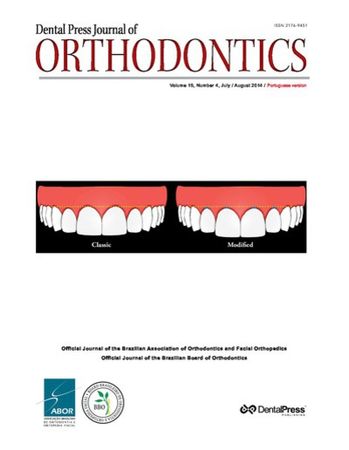Internationalization
Globalization and internationalization are terms of the corporate world. In this scenario, mastering the English language is indispensable and with Brazilian science is not different. CAPES (Coordination for the Improvement of Higher Education Personnel) and CNPq (National Council for Scientific...
Autores: David Normando,
messages.RevistaAutores:
LEIA MAIS
orthodontics highlights
The literature extensively reports the need for a certain degree of asymmetry between the right and left sides of the face, which give facial contour a natural form. Should both sides of the face be completely symmetrical, they give the person an artificial and unpleasant look. Nevertheless,...
Autores: Matheus Melo Pithon,
messages.RevistaAutores:
LEIA MAIS
The use of bisphosphonates does not contraindicate orthodontic and other types of treatment!
Bisphosphonates have been increasingly used not only to treat bone diseases as well as conditions such as osteopenia and osteoporosis, but also in oncotherapy. The use of bisphosphonates induces clinicians to fear and care. These reactions are associated with controversy resulting from lack of...
Autores: Alberto Consolaro,
messages.RevistaAutores: Osteomyelitis, Bisphosphonates,
LEIA MAIS
An interview with Nigel Harradine
Dr. Nigel Harradine qualified as a dental surgeon from Guys Hospital, London and also underwent undergraduate medical training, qualifying again from Guys. A medical house physician post followed at Guys and then a year as an intern in London, Ontario before he settled on orthodontics as his...
Autores: Weber Ursi, Ricardo Moresca, Mauricio Accorsi, John Pobanz,
messages.RevistaAutores:
LEIA MAIS
Influence of initial occlusal severity on time and efficiency of Class I malocclusion treatment carried out with and without premolar extractions
Introduction: The aim of this retrospective study was to compare the occlusal outcomes, duration and efficiency of Class I malocclusion treatment carried out with and without premolar extractions in patients with different degrees of initial malocclusion severity. Methods: Complete records of...
Autores: Guilherme Janson, José Fernando Castanha Henriques, Ruben Leon Salazar, Vladimir Leon Salazar,
messages.RevistaAutores: time, efficiency, Tooth extraction, Class I malocclusion,
LEIA MAIS
Comparative study of dental cephalometric patterns of Japanese-Brazilian, Caucasian and Mongoloid patients
Introduction: The objective of this study was to identify the patterns of dental variables of adolescent Japanese-Brazilian descents with normal occlusion, and also to compare them with a similar Caucasian and Mongoloid sample. Methods: Lateral cephalometric radiographs were used to compare the...
Autores: Renato Rodrigues De Almeida, Arnaldo Pinzan, José Fernando Castanha Henriques, Renata Sathler, Thais Maria Freire Fernandes,
messages.RevistaAutores: Orthodontics, Ethnic group, Reference standards,
LEIA MAIS
Skeletal maturation in individuals with Down’s syndrome: Comparison between PGS curve, cervical vertebrae and bones of the hand and wrist
Introduction: This study was conducted with the aim of adapting the methods developed by Martins and Sakima to assess skeletal maturation by cervical vertebrae in the pubertal growth spurt (PGS) curve. It also aimed to test the reliability and agreement between those methods and the method of...
Autores: Danilo Furquim Siqueira, Eduardo Kazuo Sannomiya, Glauber Carinhena,
messages.RevistaAutores: Cervical vertebrae, Down’s syndrome, Age determination by skeleton, Sesamoid bones,
LEIA MAIS
In vitro cytotoxicity of self-curing acrylic resins of different colors
Objective: The aim of this study was to assess the in vitro cytotoxicity of acrylic resins of different colors over time. Methods: Specimens were divided into 4 groups (n = 6) according to the color of the acrylic resin (Orto Class, Clássico, Campinas, São Paulo, Brazil): Group 1: clear...
Autores: Matheus Melo Pithon, Orlando Motohiro Tanaka, Luciana Borges Retamoso, Taís De Morais Alves Da Cunha, Rogério Lacerda Dos Santos, Fernanda Otaviano Martins, Maria Teresa Villela Romanos,
messages.RevistaAutores: Acrylic resins, Cell culture techniques, Cytotoxins,
LEIA MAIS
Three-dimensional dental arch changes of patients submitted to orthodontic-surgical treatment for correction of Class II malocclusion
Introduction: This study assessed the three-dimensional changes in the dental arch of patients submitted to orthodonticsurgical treatment for correction of Class II malocclusions at three different periods. Methods: Landmarks previously identified on upper and lower dental casts were digitized...
Autores: Ary Dos Santos-Pinto, João Roberto Gonçalves, Daniela Gamba Garib, Adriano Porto Peixoto,
messages.RevistaAutores:
LEIA MAIS
Lateral cephalometric diagnosis of asymmetry in Angle Class II subdivision compared to Class I and II
Introduction: Lateral cephalometric radiographs are traditionally required for orthodontic treatment, yet rarely used to assess asymmetries. Objective: The objective of the present study was to use lateral cephalometric radiographs to identify existing skeletal and dentoalveolar morphological...
Autores: Lídia Parsekian Martins, Ertty Silva, Ary Dos Santos-Pinto, Renata De Cássia Gonçalves, Aparecida Fernanda Meloti,
messages.RevistaAutores: Cephalometry, Facial asymmetry, Radiography, Malocclusions,
LEIA MAIS
Lateral cephalometric radiograph versus lateral nasopharyngeal radiograph for quantitative evaluation of nasopharyngeal airway space
Objective: This study compared lateral radiographs of the nasopharynx (LN) and lateral cephalometric radiographs (LC) used to assess nasopharyngeal airway space in children. Material and Methods: One examiner measured the nasopharyngeal space of 15 oral breathing patients aged between 5 and 11...
Autores: Rejane Targino Soares Beltrão, Guilherme Janson, Daniela Gamba Garib, Suelen Cristina Da Costa Pereira,
messages.RevistaAutores: Orthodontics, Radiology, Nasopharynx,
LEIA MAIS
Effectiveness of orofacial myofunctional therapy in orthodontic patients: A systematic review
Objective: The aim of the present systematic review was to determine the existence of scientific evidence demonstrating the effectiveness of orofacial myofunctional therapy (OMT) as an adjuvant to orthodontic treatment in individuals with orofacial disorders. A further aim was to assess the...
Autores: Leandro Silva Marques, Raquel Gonçalves Vieira Andrade, Maria Letícia Ramos Jorge, Márcio Alexandre Homem, Saulo Gabriel Moreira Falci,
messages.RevistaAutores: Malocclusion, Orthodontics, Myofunctional therapy,
LEIA MAIS
Orthodontic post-adjustment pain control with acupuncture
Objective: This study aimed to evaluate the analgesic efficacy of systemic acupuncture therapy on the pain caused after orthodontic adjustments. Methods: An initial sample of 30 orthodontic patients with fixed appliances monthly adjusted was selected; however, only 11 participants completed the...
Autores: Ricardo Sampaio De Souza, Daniela De Cassia Faglioni Boleta Ceranto, Sandra Silverio Lopes, Nathalie Canola Moura,
messages.RevistaAutores: Orthodontics, Pain, Acupuncture analgesia,
LEIA MAIS
Tooth-size discrepancy: A comparison between manual and digital methods
Introduction: Technological advances in Dentistry have emerged primarily in the area of diagnostic tools. One example is the 3D scanner, which can transform plaster models into three-dimensional digital models. Objective: This study aimed to assess the reliability of tooth size-arch length...
Autores: Fernando Antonio Lima Habib, Carlos Jorge Vogel, Fernando Antônio De Lima Habib, Gabriele Dória Cabral Correia,
messages.RevistaAutores: Dental models , Three-dimensional imaging, Computer-assisted diagnosis,
LEIA MAIS
In vitro study of color stability of polycrystalline and monocrystalline ceramic brackets
Objective: The aim of this in vitro study was to analyze color stability of monocrystalline and polycrystalline ceramic brackets after immersion in dye solutions. Methods: Seven ceramic brackets of four commercial brands were tested: Two monocrystalline and two polycrystalline. The brackets were...
Autores: Luiz Gonzaga Gandini Júnior, Ary Dos Santos-Pinto, Luiz Guilherme Martins Maia, Cibele Braga De Oliveira,
messages.RevistaAutores: Orthodontic brackets, ceramics, Color,
LEIA MAIS
Two-phase treatment of patients with crossbite and tendency toward skeletal Class III malocclusion*
Angle Class III malocclusion is characterized by an inadequate anteroposterior dental relationship which may or may not be accompanied by skeletal changes. In general, patients are distressed by a significantly compromised facial aspect which, when associated with a deficient middle third,...
Autores: Maria De Lourdes Machado Bayerl,
messages.RevistaAutores: Angle Class III malocclusion, Maxilla, Palatal expansion techniques,
LEIA MAIS
10 commandments of smile esthetics
The search for esthetic treatment has persisted in the routine of dental professionals. Following this trend, dental patients have sought treatment with the primary aim of improving smile esthetics. The aim of this article is to present a protocol to assess patient's smile: The 10 Commandments...
Autores: André Wilson Machado,
messages.RevistaAutores: smile, Dental Esthetics, Orthodontics,
LEIA MAIS



